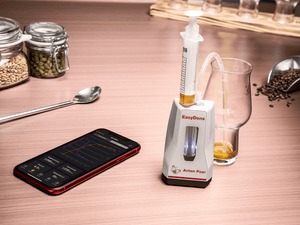Determine the alcohol content of liqueur with the EasyDens & SmartRef Combo

We are excited to introduce our spectacular new Proof Meister App feature: Alcohol content measurement in liqueur! Find out more about how it all works and what improvements are waiting for you.
Sweet or bitter, aperitif or digestif, pure or mixed - liqueur is characterized by its diversity.
As diverse as liqueur can be, its alcohol range is just as wide. The alcohol content can range anywhere from around 15 to 50 % alcohol. Therefore, the precise measurement of alcohol is of great importance and a big challenge for hobby manufacturers.
When is a drink called liqueur
There are endless types of liqueurs. As soon as sugar, water, alcohol and extracts come together it is called liqueur. Different ingredients can serve as a flavoring, such as fruits, herbs, roots, etc. These flavorings are often the manufacturer's secret. Manufacturers can be relatively flexible when choosing the alcohol, flavorings and sugar. However, there is a minimum alcohol content of 15 %v/v and a minimum sugar content of 100 g/L for the drink to be called a liqueur.
Liqueur can be divided into different types according to its ingredients: bitter-, herbal-, fruit-, spice-, coffee-, cocoa-, tea-, honey-, nut- or emulsion-liqueur.
How to measure the alcohol content of liqueur
When you produce your own liqueur, you are going to ask yourself how much alcohol is actually in it. A more accurate determination becomes particularly important if you are considering selling your creations.
If your composition contains more than alcohol and water - as is the case with a liqueur - you will no longer be able to determine the alcohol content by measuring the density alone. The typical reference method for determining alcohol in liqueurs is a distillation procedure. Here the alcohol is removed from the solution mixture by distillation. The subsequent density measurement of the distillate and the distillation residue allows the exact calculation of the alcohol. However, this is a very time-consuming process and is usually not carried out by hobbyist manufacturers.
Our solution: The EasyDens & SmartRef Combo for ABV measurement of liqueur
This perfect combination of EasyDens (density measurement) and SmartRef (refractive index measurement) enables the alcohol content measurement of liqueur without prior, complex distillation. The associated Proof Meister mobile app carries out the temperature compensation as well as all necessary calculations completely automatically and the alcohol value can be determined with an impressive accuracy of 0.6 %v/v.
Fantastic performance: The EasyDens & SmartRef Combo vs. distillation
To demonstrate how well the combination of density and refractive index measurement works for alcohol content determination in liqueur, we tested a whole variety of samples. We distilled the samples for reference and tested them in the laboratory. At the same time, we used the EasyDens & SmartRef Combo. For this, the sample was filled into both devices without further preparation and measured directly. The results are shown in the table below, including the percentage of alcohol stated on the label.
Table 1: EasyDens and SmartRef ABV results of liqueurs compared to distillation and label

As you can see in the table above, the ABV values measured with EasyDens and SmartRef fit well with the results of the distillation, all perfectly within the specifications.
How to measure your liqueur with EasyDens and SmartRef
- Connect EasyDens and SmartRef to your Proof Meister mobile app.
- Ensure that both devices are well cleaned (EasyDens Device Diagnosis) and adjusted (SmartRef Zero Adjustment).
- EasyDens & SmartRef advice: Fill and measure your liqueur at room temperature. Make sure that the temperature of the liqueur does not differ too much (+/- 2 °C) from the temperature of your EasyDens and SmartRef. Do not measure the liqueur straight from the fridge.
- Make sure your liqueur is a homogeneous solution. If necessary, shake or stir it.
- If there are particles in your liqueur, filter your sample before the measurement.
- Note, one sample is used for both devices.
- Start the measurement with “Measure ABV”.
- SmartRef advice: Since liqueurs are high in sugar and alcohol, it is important to measure the sample within max. one minute after filling into the sample well. If you wait longer for the measurement alcohol can start to evaporate and sugar can settle down, which will falsify the SmartRef values.
- You will get the results of your alcohol content within a few seconds.
- Save your measurements in your batches.
- Thoroughly rinse the device after your measurement with warm water and subsequently with deionized water.
That´s it!
EasyDens and SmartRef – for more insight into your liqueur!




